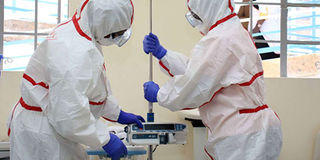East African nations ponder tough Covid-19 decisions

Nurses at Mbagathi Hospital on March 6, 2020 participate in the launch of an isolation and treatment centre for coronavirus patients. PHOTO | FILE | NATION MEDIA GROUP
What you need to know:
- What is striking though in the face of Covid-19 is just how inadequate humans still are in rapidly understanding new viruses.
- The coronavirus has shown that the knowledge to land a probe on Mars or man on the moon is really small beer in the bigger scheme of consequential things.
This week, in most of East Africa, we are entering the first monthly anniversary of lockdowns imposed to deal with the novel coronavirus pandemic.
Uganda’s has been extended by 21 days, and as Kenya continues to post confirmed cases, with the country having 225 cases by Wednesday, the highest in the East African Community, it might yet resort to a nuclear option, closer to Uganda’s and Rwanda’s.
In Rwanda, they now have even deployed drones to reinforce stay-at-home messages, and you are advised not to come out and peep at them.
Uganda can get away with it, and Rwanda can administer it. Kenya, I am not sure. To that shortly. Now, though, like almost everywhere else in the world, we are all resorting to social distancing and staying at home, as our best weapon to deal with the coronavirus.
The noble, yet also cynical idea, is that the chain of infection will be broken; those who are infected will recover, or die off.
The survivors can then go back to their merry lives, faced by an acceptable or “normal” Covid-19 risk, equivalent to that of being run over by a drunken driver, falling down an open manhole on the street and breaking your neck, or being killed in an armed robbery.
ISOLATION
In a short while, a vaccine or treatment that works will be developed, and those of us who can afford the princely sum it will cost in the early stages, will be able to fork out the money for an injection, and we will be good to go.
There is something medieval in quarantining and isolation to deal with diseases we don’t fully understand or have cures for. Our father was principal at a college not too far from the main town in northeastern Uganda, Soroti.
As you head northward to Soroti you pass by a now bustling town called Kumi, where you find dozens of Kenyan trucks loading up with food on most days.
When we were growing up in those parts, it was a quieter market known for its railway stop, as a local milk collection centre, with a smattering of small business people, and at its edge a leprosy centre. Occasionally, a few leprosy patients walked about in the town, deformed by the illness.
There were two or three other leprosy centres in the country, and about double that in the rest of East Africa. In Tanzania, Kindwitwi Leprosy Care Centre in Rufiji is alive and well.
In earlier centuries, in Europe and Asia, lepers were placed in asylums. It is our way. If we don’t understand a disease, we lock away or isolate people who have been stricken by it.
HUMAN LIMIT
We then throw voodoo and all manner of hopeful treatments at it, until some of them stick on the wall.
In the case of leprosy, a reading of the early treatments is as comedic and pathetic as it is horrifying: cobra venom, bee stings, scorpions, frogs, and even castration, to name a few in a long list.
Hiding, and fumbling from a safe distance has, no doubt, served us well. What is striking though in the face of Covid-19 is just how — with all the scientific advances — inadequate humans still are in rapidly understanding new viruses, and how even more poorly developed our knowledge for developing cures is.
The coronavirus has shown that the knowledge to land a probe on Mars or man on the moon is really small beer in the bigger scheme of consequential things.
Yet the easier option of organising curfews, lockdowns, quarantines, social distancing, is not as easy either. Apart from state capacity, structural issues, some of which are a positive and serve well in good times, can be a big hindrance.
This is nowhere more evident than the options available to Kenya, Rwanda, and Uganda. For many reasons, including some very specific ones about how the 1994 genocide was executed, Rwanda is today a very mapped country.
MAPPED OUT
There is virtually no street without a name, and almost no house, even in the poorer parts of cities, that doesn’t have a number on it. It is thus very easy to organise relief distribution during a lockdown.
Kenya and Uganda are messy, but Uganda’s staple foods like millet and bananas are not bought from supermarkets or shops, the way maize flour for ugali in Kenya is. The food comes from various medium-size and small (many informal) markets, and not grown too far away.
Because Kenya is more urbanised, eats ugali, and is a larger economy, the supermarkets and shops are far more important.
By contrast, there’s probably no home in Kampala that is so far away that a villager cannot carry a bunch of bananas on her head, deliver it on foot or by boda-boda and walk back to her home before the curfew and its whip-wielding enforcers take over the streets and roads.
For Kenya, it would be a very painful course. Yet, without a miracle bitter root, vaccine or cure, a risky gamble might be all it has left.
Mr Onyango-Obbo is curator of the Wall of Great Africans and publisher of explainer site Roguechiefs.com; @cobbo3





